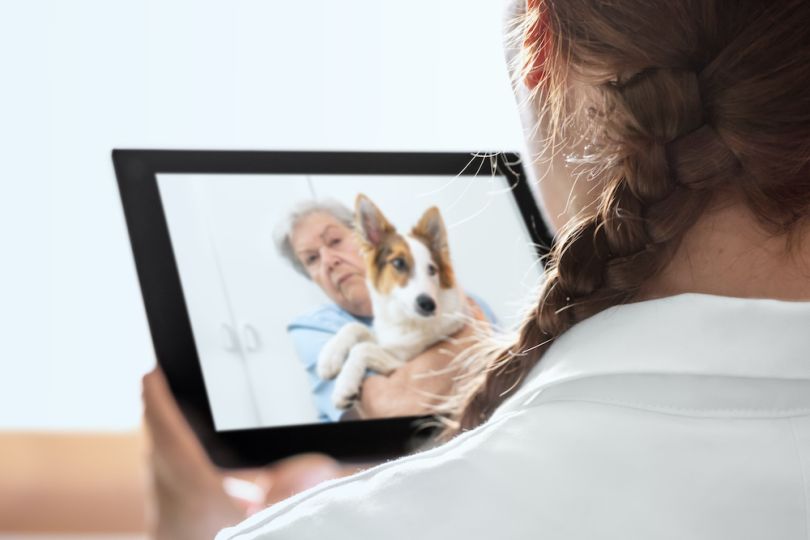With more than 38 million Americans filing for unemployment because of the coronavirus pandemic, gig-based platforms like Uber, GrubHub and Instacart have been flooded with sign-ups by ready-and-willing workers looking to make ends meet. For many of these companies, though — especially ones that don’t specialize in essential-item delivery — the demand for their services has gone in the opposite direction of their service-worker supply.
Shelter-in-place orders have all but wiped out most consumers’ need to hail rides, rent vacation homes or book dog walkers. As a result, platforms that provide on-demand services have had to scramble to diversify their product offerings.
That includes Wag, the on-demand dog-walking service that allows “pet parents” to summon a “pet caregiver” in 20 minutes, sometimes less. If dog owners are staying home, in most cases they probably wouldn’t want to pay a stranger to walk it.
Recently, the company rolled out new services — some in direct response to the crisis, and some that were already in the works, but fast-tracked through production — to help offset the lack of demand for its core offering.
To learn more about how Wag has maneuvered during the crisis, Built In spoke with the company’s chief operating officer, Dylan Allread.

With people staying home, how does your business — known for its dog-walking service — still work?
We’re going to stick to our core business, which is on-demand pet services. COVID-19 has expedited our product roadmap. We had some things planned, and so we reorganized that just in response to COVID — things we wanted to work on and have fine-tuned because of it.
One is a telehealth solution, called Wag Health. We have a monthly subscription service, Wag Premium, and, through that, people get 10 percent off their services. They also get access to VIP customer care and now they get access to a veterinarian Q&A, where they can submit a question and get a response within 24 hours. Beyond that, there’s also a chat feature that’s used in situations where it may not be an emergency, and someone’s deciding if they want to make that expensive trip to the vet. Without marketing, we rolled out the chat as well as the Q&A, and in the first week we had a thousand questions come in. That has remained steady over time. And what's cool about this is we’ve actually seen that convert people to Wag Premium so that they can utilize this ongoing.
And you rolled out a pet food delivery service too, right?
Wag Now is probably going to be COVID-specific. Our core business, walking, was down 70 percent after about a month. As we saw services start to dip, we looked at both sides of the marketplace, and thought we need to keep pet parents and pet caregivers happy. What that means is offering services that pet parents need, but also providing more services to pet caregivers so they can earn the dollars that they rely on.
“We were looking for something that we could build quickly to help both sides of the marketplace.”
Ultimately, we were looking for something that we could build quickly to help both sides of the marketplace. We saw that people had requests for pet food delivery, and requests for their dogs to be taken to and from the vet because they were a part of a vulnerable population and didn’t want to leave the house. And so we were able to create that product. That being said, in the early stages, it was very, very manual. We were basically iterating on a daily basis, but we got it out fast.
Is educating customers about these new products a challenge, since they mainly know Wag as the dog-walking service?
It’s really tough because, as you can imagine, a lot of companies across the industry have frozen their marketing budgets. We’re not spending a lot of money on performance marketing. A lot of this is organic. We do have fine-tuned, well-tailored email communications that we send out. We also are looking to leverage our social networks; we’ve doubled down on our social initiatives. That was something that we wanted to do at the beginning of this year anyway. We are actually posting to our social networks more regularly, we’re reaching out to influencers as well as trainers and others dog experts on social to get the word out.
How do you acquire veterinarians? Is that tricky — adding a third constituency to your marketplace?
When we first started out, we actually leveraged Upwork, and right now it’s actually a good time to roll it out because there are vets seeing fewer customers coming into their doors because fewer people are leaving their homes. So vets are actually looking for ways to leverage telehealth.
We think as we iterate on this, it will become bigger and better. As we look to partner with more vets, I think there are some things that we’ll look at. But it was probably a little bit easier, given that we weren’t going to see 20,000 services provided by vets in the first week; we were just going to see a few. So we were able to talk to and find the right few vets who could answer these questions in a timely manner.

What has Wag done to support its pet caregivers during the crisis?
We have a great deal of pet caregivers already, so we created a waiting list because we didn’t want to dilute the work that is still going on for the pet caregivers who have been with us the longest. And like many other companies, we’re pointing people to the CARES Act and other things.
We also looked into other services that make sense for the pet caregiver side. We did some surveying and some outreach to see what type of opportunities caregivers want and some things that pet owners want. One thing that we were working on before COVID was pet training. That’s something that we wanted to roll out, so we expedited that and are actually going to roll out a digital training effort. That’s currently in the works. That idea came from reaching out to the pet caregivers and finding out that a great deal of them actually do training, that’s their expertise. There’s additional things we need to do to ensure that we vet them as trainers as we roll out this product.
You’ve been able to avoid additional layoffs and furloughs during the crisis?
Yeah, that is the case. One of the things that has been the most challenging is that families are impacted. At Wag, when the [Families First Coronavirus Response Act: Employer Paid Leave] came about, that to me was like — this is something that HR people should be loving. We’ve been hoping for the government to back this type of program for so long. I know it’s only temporary, but we found a way to make it work here at Wag, and we actually have a decent number of people out on FFCRA leave. When you’re dealing with all different types of things, building programs and new initiatives as well as reshaping policies and processes, it’s tough when people go out, but we’ve been able to adapt quickly and shift some focus areas around to ensure that we're still operating as quickly and fast as possible.
How is operating this business a logistical challenge?
What’s really tough is you’re talking about on demand in a space that deals with not just two customers, but also a pet. When you think about that, that means having to get into the home, having to do all these other things when the pet parent isn’t there. And so you have to think about all the challenges that may come up along the way. I think that’s why you haven’t seen that many companies actually come into the on-demand walking space — because it’s hard to find somebody nearby to walk a dog within 20 minutes’ time.
Part of it is, because it’s a 1099 relationship, we’re not training or doing a lot of those other things. So we need to ensure that our processes for activating walkers on the Wag platform are good, but also in a way where we don’t need to train after. I think that speaks volumes to how our activations team has really gone a long way to ensure that we have the best dog walkers providing services on the platform.
This conversation has been edited for length and clarity.




